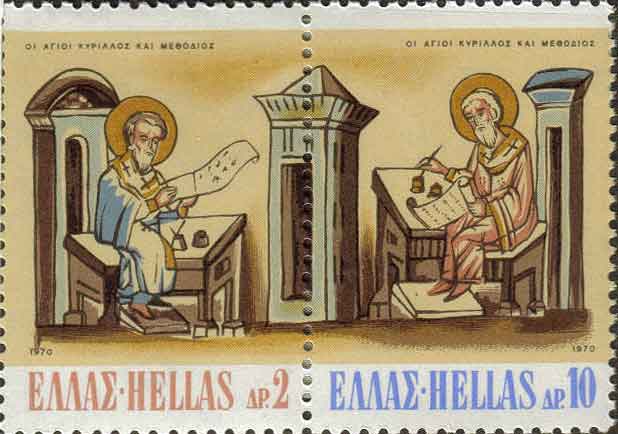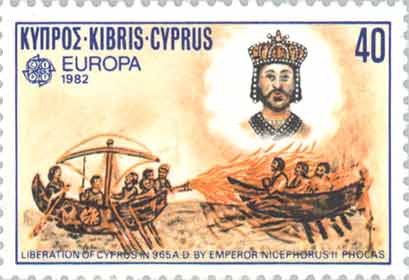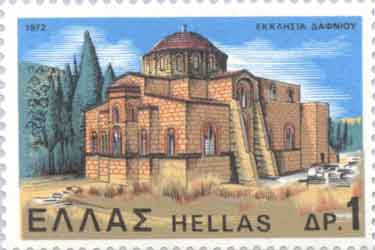
The brothers Saint Cyril and Saint Methodius from Thessaloniki
Medieval Greece
A Period of 1123 years and 18 days....until the 29th March 1453, a Tuesday, at 2:30
...a worthless collection of declamations and miracles, a disgrace for the human mind Voltaire, Le pyrrhonism de l’histoire, The Making of Byzantinism (PDF File)
Part of the so called “Byzantine Empire” formed by the East Roman Empire by the Roman Emperor Flavius Valerius Constantinus or Constantine I The Great (who had a vision of Chi (χ) and Rho (ρ) on the Sky, the first letters of “Christos” in Greek and the Greek words en touto nika, “win by this”). A Roman political system and organization, Christian Religion and Greek language as the official language of the Empire with oriental culture influence although the Emperor Justinian I was mainly Latin speaking.
It is not surprising that some historians consider Byzantium as a Greek Empire (even if the Greek population was small). Official it was a Roman Empire and its citizens were “Romans” formed by Syrians, Greeks, Armenians, Slavs etc. The influence of ancient Greek culture, philosophy and science is often ignored in Roman history and maybe it would be better to consider Byzantium not only as a Roman Empire but as a Christian Greco-Roman Empire.
After elimination of the Persian danger the Empire concentrated its efforts a few centuries to fight against the Muslims. In the year 1204, 13th April, the Crusaders conquered Constantinople. Even if the Byzantines gained control again in 1261 it was more a small kingdom rather than an empire.
Memoirs or Chronicle of the Fourth Crusade and the Conquest of Constantinople Geoffrey deVillehardouin
Like in the West a society dominated unfortunately by the Church mainly represented by the Emperor. Fortunately a small part of the ancient Greek knowledge survived (also due the work of Arabs). It was only after the 13th century when scholars considered the ancient Greek texts that survived less dogmatic. In this period we have also most of the important byzantine scientists. Some interesting scholars: Johannes Tzetzes, Georgios Gemistos and Manuel Chrysoloras. An important modern Greek scholar of the Medieval period was Milton Anastos. Cosmas Indicopleustes (Κοσμάς ο Ινδικοπλεύστης) who is considered a Geographer (actually a merchant and traveler) refused to believe the ancient Greek ideas of a spherical world and their astronomical knowledge and created a model of the world derived from the Bible. Reading parts of his Christian Topography we see a transition back from Logos to Mythos. Theological studies were supported such as Angelology, the science of angels.
Christian Topography Greek Text
But with even greater wisdom ye suppose that there are men walking the earth over with their feet opposite the feet of other men. We therefore depict according to your view the earth and the Antipodes. And let each one of you who has sound vision and the power of reasoning justly turn the earth round whatever way he pleases, and let him say whether the Antipodes can be all standing upright in the same sense of the expression. But this they will not show even should they speak unrestrained by shame. Such then is our reply to your fictitious and false theories and to the conclusions of your reasonings which are capricious, self-contradictory, inconsistent, doomed to be utterly confounded, and to be whirled round and round even more than that unstable and revolving mythical sphere of yours. Wherefore, O Christ-loving Father, since I have thus brought an end to the fourth book with a delineation of the Antipodes, I shall begin the fifth book, as I promised at thy pious desire, and it will contain a description of the tabernacle prepared by Moses in the wilderness, if God will, who is Saviour of us all. Cosmas Indicopleustes, Christian Topography
Anthemius of Tralles (Ανθέμιος Τραλλειανός) an interesting and important mathematician
Isidorus of Miletus (Ισίδωρος ο Μιλήσιος) and Anthemius of Tralles designed the Hagia Sophia church (Holy Wisdom of the Logos) build in 532 - 537 after previous churches were burned down by fanatics for various reasons. It was so big (the biggest church dome until the 15th century) that it had to be repaired a few times after earthquakes in 557 ( 558 collapse of the dome), 869, 989, 1344, 1766 and 1894. Forty thousand pounds of silver were used for the sanctuary as Procopius describes. Is it not surprising that the Hagia Sophia which is considered as the most impressive building was build in the early period of the Empire? The Emperor Justinian said upon completion: My God, I am grateful to you for choosing me to complete this monument. I am now greater than Solomon.”
In 532 a crisis the Nika riots in which around 30000 are killed many building in the city Constantinople destroyed, a story which is related to chariot racing teams of the Hippodrome . Justinian was about fleeing but Theodora his wife convinced him to stay. A greater crisis is the so-called plague of Justinian, a bubonic plague outbreak that kills 5000 people in Constantinople each day. At the end 40% of the city population dies. Around 25 million dead or one quarter of the population in the Eastern Meditteranean region.
The Secret History of the Court of Justinian, Procopius
The first silk looms were set up in the royal palaces of the Roman kings in the year 533 A.D. The raw material was brought from the East for a long time but in the sixth century two Greek monks, while in China, studied the method of rearing silk worms and obtaining the silk, and on their departure are said to have concealed the eggs of silk worms in their staves. They are accredited with introducing the manufacture of silk into Greece and hence into Western Europe. After that Greece, Persia and Asia Minor made this material, and Byzantium was famed for its silks, the actual making of which got into the hands of the Jews and was for a long time controlled by them. Grace Wood
Recently Volker Hoffmann and Nikolaos Theocharis claimed that there is a mathematical model behind based on the so-called analemma, a circle inscribed in a square which is inscribed in a circle. Deciphering the "Eight Wonder of the World" (PDF, 3MB) , The Geometrical Design of the Saint Sophia (Hagia Sophia) (German)
John Philoponus of Alexandria (Ιωάννης ο Φιλόπονος) 6th century philosopher and scientist
The remarkable experimental fact that all objects fall with the same acceleration was known to the ancients. In the fifth century, a Byzantine philosopher, Iohannes Philoponus, recorded and possibly performed a Galileo-style experiment, as part of his commentary on Aristotle's Physics A Cultural History of Gravity and the Equivalence Principle
Leon the mathematician from Thessaly (c. 790 – c. 868?), with a classical education for which he even as a Christian was accused to be a pagan. He obtained his knowledge by his research of ancient sources that he found in various monasteries.
Manuel Moschopoulos (little calf) 14th century mathematician the first known publication in the West about Magic Squares "Παράδοσις εις την εύρεσιν των τετραγώνων αριθμών"
Francesco Maurolico.an Italian scientist of Greek origin, considered one of the greatest geometers of his time.
Greeks Humanists
Markos Musuros (1417 - 1530)
Constantinople was a very large city compared to other European cities with many palaces and churches (The area was around 1/3 that of Manhattan)
Medicine (A History of Science, Volume 2, by Henry Smith Williams):
We have previously referred to the influence of the Byzantine civilization in transmitting the learning of antiquity across the abysm of the dark age. It must be admitted, however, that the importance of that civilization did not extend much beyond the task of the common carrier. There were no great creative scientists in the later Roman empire of the East any more than in the corresponding empire of the West. There was, however, one field in which the Byzantine made respectable progress and regarding which their efforts require a few words of special comment. This was the field of medicine.
The Byzantines of this time could boast of two great medical men, Aetius of Amida (about 502-575 A.D.) and Paul of Aegina (about 620-690). The works of Aetius were of value largely because they recorded the teachings of many of his eminent predecessors, but he was not entirely lacking in originality, and was perhaps the first physician to mention diphtheria, with an allusion to some observations of the paralysis of the palate which sometimes follows this disease.
Paul of Aegina, who came from the Alexandrian school about a century later, was one of those remarkable men whose ideas are centuries ahead of their time. This was particularly true of Paul in regard to surgery, and his attitude towards the supernatural in the causation and treatment of diseases. He was essentially a surgeon, being particularly familiar with military surgery, and some of his descriptions of complicated and difficult operations have been little improved upon even in modern times. In his books he describes such operations as the removal of foreign bodies from the nose, ear, and esophagus; and he recognizes foreign growths such as polypi in the air-passages, and gives the method of their removal. Such operations as tracheotomy, tonsellotomy, bronchotomy, staphylotomy, etc., were performed by him, and he even advocated and described puncture of the abdominal cavity, giving careful directions as to the location in which such punctures should be made. He advocated amputation of the breast for the cure of cancer, and described extirpation of the uterus. Just how successful this last operation may have been as performed by him does not appear; but he would hardly have recommended it if it had not been sometimes, at least, successful. That he mentions it at all, however, is significant, as this difficult operation is considered one of the great triumphs of modern surgery.
But Paul of Aegina is a striking exception to the rule among Byzantine surgeons, and as he was their greatest, so he was also their last important surgeon. The energies of all Byzantium were so expended in religious controversies that medicine, like the other sciences, was soon relegated to a place among the other superstitions, and the influence of the Byzantine school was presently replaced by that of the conquering Arabians.
Nicolaos Myrepsos, pharmacology text, From, Byzantine East & Latin West: Two Worlds in Middle Ages and Renaissance
Byzantine Monuments (Computer Reconstructions)
Not since the world was made was there ever seen or won so great a treasure or so noble or so rich, not in the time of Alexander nor in the time of Charlemagne nor before nor after. Nor do I myself think that in the forty richest cities of the world there had been so much wealth as was found in Constantinople. For the Greeks say that two thirds of the wealth of the world is in Constantinople and the other third scattered throughout the world Robert of Clari, The Conquest of Constantinople. Describes the impression of a simple knight who participated in the Fourth crusade

Military Technology: A Syrian engineer (some say he was a Greek architect) Kallinikos (or Callinicus) of Heliopolis (Καλλίνικος) inventor of “Greek Fire” around 673 AD
Medieval Greek (Byzantine) Warfare
"We are Hellenes", Georgios Gemistos (Plethon)
Michael Psellus: Who was the better poet, Euripides or George of Pisidia? Who is George Pisidia you may ask? :-)
In the footsteps of a monk in 10th century Byzantium
1204: The capture of Constantinople by the Franks: a systematic destruction and looting, graphically described by Michael Choniates: `but whatever remained of the capital became the spoils of the conquerors for the entire period of their rule, which lasted about sixty years.' The wealth of books accumulated in the capital suffered incalculable damage: those that escaped the fires were stripped of their precious bindings, as is attested by the treasury of San Marco, and the rest may even have been used as heating fuel.
The evolution of the Modern Cyrillic character set from the Greek character set (an animation)


Building a Palace
Byzantine Art (from the Metropolitan Museum)
“The old religious painters fasted when they worked, and when they began an icon they changed their underclothes, so as to be pure both internally and externally. As they worked, they chanted psalms, so that their work would be executed in a spirit of contrition and so as to prevent their mind dwelling on worldly matters.” About Byzantine Art: Comments from the artists Fotis Kontoglou and Nikos Hatzikyriakos Ghikas
An Icon as an Image ( symbolism of the icons and the "images" of God " in His incomprehensibility and unknowability is "the superlight darkness".)
Byzantine Museums and Collections (Hellenic Ministry of Culture)
Iconoclasm (Eikonoklasmos, "Image-breaking"), 726 AD order of destruction by Leo III but after more than 100 years in 843 icons are finally accepted.
In 1054 for various reasons split (schism) of the Christian Church ( East and West Church ), excommunication of the Patriarch by the Pope and excommunication of the Pope by the Patriarch. After almost another 1000 years the schism continues probably until the following differences are solved : Basic Points of Difference between the Orthodox Church and Papism
An interesting icon is that of Άγιος Χριστόφορος Κυνοκέφαλος, the Saint Christopher Kynocephalos, the so-called Dog-Head, because he was considered to be from a land of cannibals with dog-headed people. He is represented in icons of the orthodox church with a dog head. He died as a Martyr 9th May 308 AD in Antioch Syria and was promoted to a Saint. According to a legend he helped Jesus Christ who was transformed in a child to pass a river, and therefore he was called Christopher. The Origin of the Cult of St. Christopher

Panagia Icon with the three hands.
The monastery of Chilandar in Athos contains the icon of Panagia tricherousa (Παναγία Τριχερούσα), or "Panagia with the three hands" who according to a legend was able to glue the cutted hand of Ioannis Damaskinos (a punishment ordered by the regent of Damascus). Damaskinos offered then a silver hand model set next to the icon.
Byzantine Jewellery
Byzantine Art, Mosaic, Child and Donkey
“For if a chant is of heavenly origin, then the acknowledgment received by man in transmitting it to posterity ought to be minimal. This is especially true when he deals with hymns which were known to have been first sung by angelic choirs - such as the Amen, Alleluia, Trisagion, Sanctus and Doxology. Consequently, until Palaeologan times, was inconceivable for a composer to place his name beside a notated text in the manuscripts.” Orthodox Byzantine Music
Dance in Byzantium
Byzantine studies on the Internet
Edward Gibbon : History of the Decline and Fall of the Roman Empire (According to Wikipedia Ireland lifted the ban on sale of this book only in the early 1970's !!! ) “I have described the triumph of barbarism and religion“
Mary G. Houston, Ancient Greek, Roman & Byzantine Costume
History
The Secret History Procopius, G. Williamson (Translator)
Birth of the Hospital in the Byzantine Empire Timothy S. Miller
ROME AND ROMANIA, 27 BC-1453 AD
What is left from Byzantium? The organon (hydraulis), the musical instrument (organ) of the church, as claimed was not a Byzantine invention but a Hellenistic (from Ktesibios or Ctesibius of Alexandria). Another invention mentioned that is supposed to be from Byzantium is the PIZZA. This would be a significant contribution although Wikipedia says that PIZZA was invented by the ancient Greeks in Italy and the Etruscans, i.e. centuries before the formation of “Byzantium” (although I could not find any reliable original sources for both stories and I assume that PIZZA was invented even much earlier..).
Byzantine princesses married to Venetians introduced the use of table forks in the West (Catholic Encyclopedia)
The Byzantine Empire had a great influence in all countries who accepted the Orthodox religion. Some say that the Byzantine Empire ended with the death of the last Tsar in Russia, with Moscow as the "3rd Rome" and Constantinople the 2nd Rome. .
Oυαί, ουαί! τέκνα μου αγαπητά, δυστυχείς απόγονοι των Eλλήνων. Eσυντρίφθη, τέλος πάντων, και ο Pωμαϊκός ζυγός, και οι Pωμαίοι Aυτοκράτορες εκρημνίσθησαν από του Bυζαντίου τον θρόνον. Aλλά τους εκρήμνισαν τίνες; Tύραννοι ασυγκρίτως και βαρβαρότεροι και σκληρότεροι απ' εκείνους: και οι ταλαίπωροι Γραικοί, αντί του να αναψύξωσιν, έκλιναν ελεεινώς τον αυχένα υποκάτω εις ζυγόν τόσον βαρύν, τόσον απάνθρωπον, ώστε να ποθήσουν τον ρωμαϊκόν ζυγόν. Adamation Korais.
John Julius Norwich, A Short History of Byzantium ,Vintage; Reprint edition 1998, ISBN: 0679772693
Charles Freeman , The closing of the Western mind : the rise of faith and the fall of reason , Knopf; 1 Amer ed edition 2003, ISBN 140004085X
Byzantinists
Sir James Cochran Stevenson Runciman
Byzantine aristocracy and bureaucracy
Links
| Ancient Greece
Science, Technology , Medicine , Warfare, , Biographies , Life , Cities/Places/Maps , Arts , Literature , Philosophy ,Olympics, Mythology , History , Images Medieval Greece / Byzantine Empire Science, Technology, Arts, , Warfare , Literature, Biographies, Icons, History Modern Greece Cities, Islands, Regions, Fauna/Flora ,Biographies , History , Warfare, Science/Technology, Literature, Music , Arts , Film/Actors , Sport , Fashion --- |